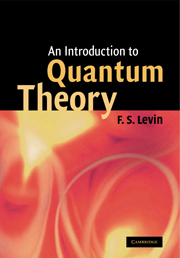Book contents
- Frontmatter
- Contents
- Preface
- PART I INTRODUCTORY
- Chapter 1 The Need for a Non-Classical Description of Microscopic Phenomena
- Chapter 2 Classical Concepts and Quantal Inequivalences
- Chapter 3 Introducing Quantum Mechanics: A Comparison of the Classical Stretched String and the Quantal Box
- Chapter 4 Mathematical Background
- PART II THE CENTRAL CONCEPTS
- PART III SYSTEMS WITH FEW DEGREES OF FREEDOM
- PART IV COMPLEX SYSTEMS
- Appendix A Elements of Probability Theory
- Appendix B Fourier Series and Integrals
- Appendix C Solution of Legendre's Equation
- Appendix D Fundamental and Derived Quantities: Conversion Factors
- References
- Index
Chapter 3 - Introducing Quantum Mechanics: A Comparison of the Classical Stretched String and the Quantal Box
Published online by Cambridge University Press: 05 June 2012
- Frontmatter
- Contents
- Preface
- PART I INTRODUCTORY
- Chapter 1 The Need for a Non-Classical Description of Microscopic Phenomena
- Chapter 2 Classical Concepts and Quantal Inequivalences
- Chapter 3 Introducing Quantum Mechanics: A Comparison of the Classical Stretched String and the Quantal Box
- Chapter 4 Mathematical Background
- PART II THE CENTRAL CONCEPTS
- PART III SYSTEMS WITH FEW DEGREES OF FREEDOM
- PART IV COMPLEX SYSTEMS
- Appendix A Elements of Probability Theory
- Appendix B Fourier Series and Integrals
- Appendix C Solution of Legendre's Equation
- Appendix D Fundamental and Derived Quantities: Conversion Factors
- References
- Index
Summary
Quantum mechanics was initially formulated as a type of matrix theory by Heisenberg and collaborators. Soon after, it was alternately expressed by Schrödinger as a wave theory through what is now referred to as the Schrödinger wave equation. Schrödinger and Eckart showed that these two approaches were equivalent manifestations of the same underlying formalism, viz., quantum theory.
Quantum theory is formulated in this book (Chapter 5) via six postulates. In order that this postulational approach not be too abstract, it is helpful first to analyze a system that is easily treated by quantum theory. We do so in this chapter, in which the so-called quantal box is studied. The analysis is carried out using the Schrödinger equation, which is introduced in this chapter but without the formal statements of the postulates.
Because the quantal-box problem is similar mathematically to the problem of describing the clamped, vibrating string of classical physics, the string is also analyzed in this chapter. This provides not only a comparison system for the box, but also a brief review of classical waves and wave theory. We also include a section on Hermitian differential operators, Sturm–Liouville systems and the Dirac delta function. All of this material serves as an introduction to Chapters 4 and 5.
We begin with the string. Because many readers will already have seen aspects of the following analysis, we put all of Section 3.1 in small print. This section may be omitted by the knowledgeable reader; the crucial result is Eq. (3.3).
- Type
- Chapter
- Information
- An Introduction to Quantum Theory , pp. 46 - 83Publisher: Cambridge University PressPrint publication year: 2001



